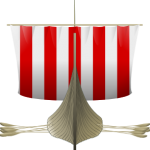Tags

A recent article on RÚV talks about Danish archaeological research showing that a Viking-age woman has ties to North American Indian tribes, using a technique that measures levels of strontium in the teeth, as well as DNA analysis from her bones. The strontium in the teeth reveals where a person was born and lived the early years of their life, while the strontium in bones shows where a person lived during the end of their life. Since strontium isotopes differ from region to region, this allows researchers to detect a person’s migration during their life.
Víkingakona reyndist af ættum indíána
Viking Woman Proves To Have Indian Ties
“Nýjar rannsóknir danskra fornleifafræðinga á erfðaefni víkingakonu sýna tengsl milli Norðurlandabúa og indiána í Norður-Ameríku á víkingaöld.”
“New Danish archaeological research into the DNA of a viking woman shows links between Nordic inhabitants and Indians in North America during the Viking age.”
The Icelandic word for DNA is interesting, combining the word efni (matter, substance) with a prefix having to do with heredity or inheritance (erfð-). Some related words containing this root are:
erfð f (-ar,-ir) inheritance erfðir f pl heredity erfðaefnis·breyting f genetic change erfða·fræði f genetics erfða·venj/a f tradition
“Rannsóknirnar sýna að kona frá víkingaöld, sem fannst í gröf á Fjóni, á ættir að rekja til indiána Norður-Ameríku. Við rannsókn fornleifafræðinga á grafstæði frá árunum 800 til 1100 nærri Otterup í Galgedil á Fjóni kom m.a. í ljós gröf ungrar konu.”
“The research shows that a Viking-age woman, found in a grave at Funen, has a family line that traces back to Indians of North America. Among other things, archaeological research at a gravesite from the years 800 to 1100 near Otterup in Galgedil on Funen uncovered the grave of a young woman.”
|
|
|||||||||||||||||||||||||||||||||||||||||||
The word for grave (gröf) comes from the same root as the word for dig or bury (grafa).
“Sjá mátti af geislavirku strontíum í tönnum hennar að hún var uppalin í Danmörku en styrkur strontíum sem upphaflega kemur úr drykkjarvatni og er mismunandi frá einum stað til annars, segir til um hvar fólk býr fyrstu ár ævinnar. Þá kom í ljós að erfðaefni í beinunum var af gerðinni haplotypu X2 c sem er sjaldgæft í Evrópu og finnst ekki í Asíu en er algengt í Norður-Ameríku.”
“It could be seen from the radioactive strontium in her teeth that she was raised in Denmark; the level of strontium that originally came from drinking water, and which differs from place to place, indicates where a person lived during the first year of their life. It was discovered that the DNA in her bones was of the halotype X2c, which is rare in Europe and not found in Asia, but is common in North America.”
The word uppalinn (raised, brought up) comes from the verb ala:
| að ala – to bear, nourish | ||
|---|---|---|
| present | past | |
| ég | el | ól |
| þú | elur | ólst |
| það | elur | ól |
| við | ölum | ólum |
| þið | alið | óluð |
| þau | ala | ólu |
So ala upp is to bring up (raise), and in reflexive form you find phrases like:
Ég ólst upp í Reykjavík. – I grew up in Reykjavik.
“Vísindamenn telja því að konan sé ekki ættuð frá Skandinavíu, annarrar kynslóðar innflytjandi í Danmörku. Hún sé líklegast komin frá Vínlandi þangað sem Íslendingar og Grænlendingar af íslenskum ættum sigldu. Gröf konunnar lá í norðaustur og suðvestur og með henni hafði verið lagður hnífur. Það telur Sören Michael Sindbæk, sem stýrir rannsókninni, benda til að gröfin sé frá heiðnum tíma.”
“Scientists believe that the woman is not from Scandanavia, but a second generation immigrant to Denmark. She most likely came from Vinland, where Icelanders and Greenlanders of Icelandic heritage sailed to. The woman’s grave lies northeast and southwest and a knife had been placed with her. To Sören Michael Sindbæk, who directs the research, this indicates that the grave is from heathen times.”
reyn/ast v (acc) turn out, prove ætt f (-ar,-ir) family fornleifa·fræði f archaeology erfða·efni n (-s,-) DNA tengsl n pl connection, link gröf f (grafar,grafir) grave sjald·gæfur adj rare, unusual kyn·slóð f (-ar,-ir) generation ætt/aður adj (f -uð) come from (geneology)
